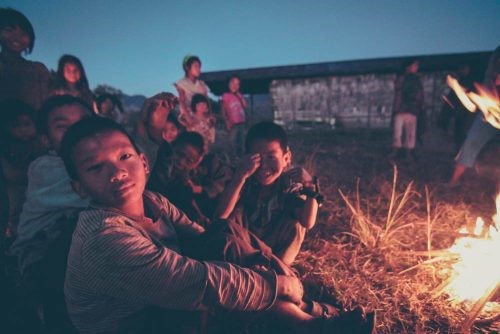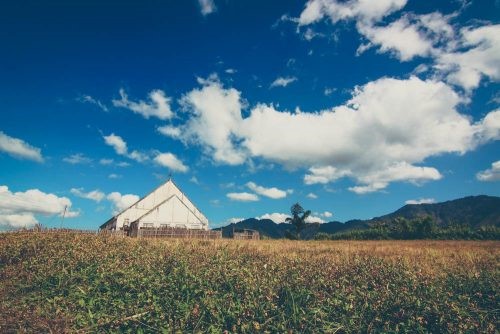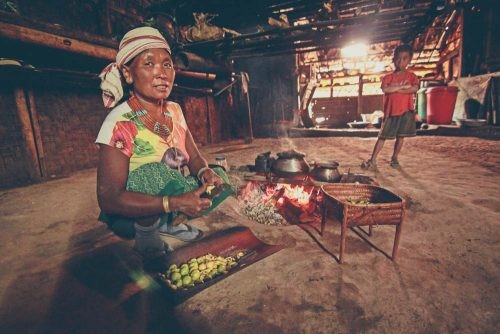Meet the Konyaks of Nagaland, Renowned as Headhunters, and for Their Famous Facial Tattoos
Many of India’s indigenous tribes and cultures in remote areas of the country still live following practices handed down from generation to generation. Traveller and blogger Neelima Vallangi talks about the time she spent with one such tribe – the famous Konyaks of Nagaland.
On a bright Sunday afternoon, I was standing on a hilltop, one foot in India and the other in Myanmar. With neither a passport nor a visa in hand, there I was straddling an international border [another thing off the 30 before 30 list]. In front of me were the mountains of Myanmar, covered in a dense blanket of lush greenery. To my left, located on a ridge below, was the traditional Naga village of Longwa in India.
The mountain air was fresh and knew no borders, but at that moment, I did.
Children of the Chief and the villagers, hanging out by the bonfire in the church grounds of Longwa, a remote Konyak Naga village situated on the Indo-Myanmar border
Two days ago, there was nothing remarkable about the jam-packed, rickety, and dirty bus journey along the broken mountain roads from a little border town in Assam called Sonari to Mon town in north Nagaland. But it was only until an old man climbed into the bus and sat next to the driver facing the crowd. Instantly I knew he had killed at least one man. How did I know that? Because of the dark tattoo on his face and the necklace with brass faces adorning his chest. He wore colorful beaded ornaments around his neck. His ears were pierced with long animal horns jutting out. He wore a headgear that was decorated with wild boar’s teeth! Never in my life had I seen so many vestiges of slaughter on one person. He was a Konyak Naga Headhunter.
The Konyaks are the largest of the 16 tribes inhabiting Nagaland. Located in the mountainous regions of the northeast, they are spread across Nagaland and Arunachal Pradesh in India, and Myanmar. They come with a history of brutal headhunting and animistic culture. Severing heads was a common practice amongst Konyaks until as recently as 1940s, with the last reported head hunting in 1970s. Capturing an enemy’s head was the rite of passage for boys to turn into men, as capturing the head symbolically represented capturing the enemy’s spirit.
Only a person who had successfully hunted a head was given the prestigious facial tattoo.
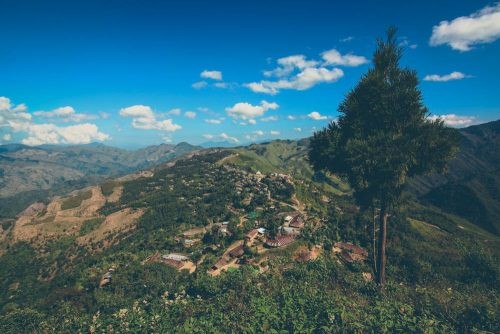 Longwa village, as seen from a vantage point. To the left is India, to the right is Myanmar
Longwa village, as seen from a vantage point. To the left is India, to the right is Myanmar
A day after I reached Mon town, I headed to Longwa, one of the bigger and more traditional Konyak villages. The first glimpse of the village made quite an impression. Sitting atop a ridge of a far-ahead mountain, Longwa commands a grand view of the valleys and mountains around. Naga villages were strategically built upon hilltops and ridges so that they could monitor enemy activity and impending raids. Konyaks were known to be the fiercest of headhunters, and raids between villages were quite common. Neighboring villages were raided to command authority and acquire land.
Konyaks are still ruled by hereditary chieftains known as Anghs. When we arrive at Longwa, as per the tradition, we first visited the Angh as soon as we reached. I could recognize the Angh by the turquoise blue beads he wore below the knees. A necklace with brass faces was hanging around his neck; however he wasn’t a headhunter. He had inherited the position and the necklace from his father, who was a headhunter.
The practice of polygamy is prevalent among the Anghs, and the chief here had several children from many wives.
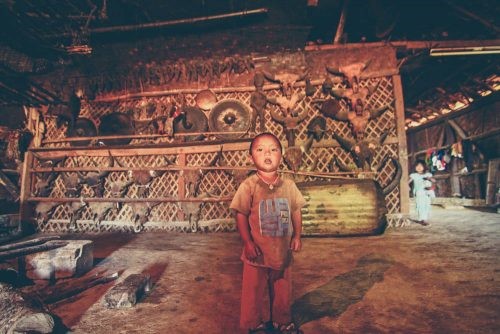 Proud hunters. Earlier, human skulls were also part of this elaborate display. Since becoming “civilized”, the human skulls are gone, but the animal skeletons still remain
Proud hunters. Earlier, human skulls were also part of this elaborate display. Since becoming “civilized”, the human skulls are gone, but the animal skeletons still remain
Hanging out with the children as they warmed themselves around a bonfire in the vast church ground was a surreal experience! The fire quickly died down as the darkness descended upon us, bringing a deep chill along with it. The stars came out and filled the sky. I walked down the road that goes through the village. In the darkness, one of the Chief’s sons pointed towards the mountains in front of me and said that is Burma, and hidden inside those forests is the Burmese check post. I chuckled, wondering if I had to take his words with a pinch of salt. Earlier that evening, I was told the house of the Angh is longitudinally split between the two countries, and that the international border actually cuts across the house and the village! The joke around here is that the Angh dines in India and sleeps in Myanmar.
I wasn’t very convinced of the border story.
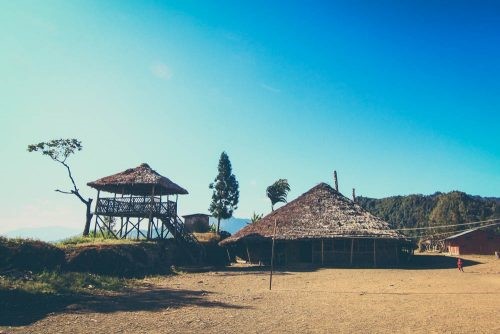 House of the Village Chief, or “Angh”. It lies half in India and half in Myanmar. The international border cuts across the house longitudinally!
House of the Village Chief, or “Angh”. It lies half in India and half in Myanmar. The international border cuts across the house longitudinally!
Later that night, we huddled ourselves around the kitchen fire inside Wanlem’s traditional bamboo house, accompanied by her family. Wanlem was my host in Longwa, a young Konyak lady who is the caretaker of the rest house. Accompanying me was Aching, a young college boy from Mon, acting as my translator. Very few people speak English, and even fewer speak Hindi in the remote parts of Nagaland. Nagamese is the script-less language spoken predominantly in Nagaland, which is a mix of Hindi and Assamese. While Wanlem and Aching conversed, I couldn’t follow their conversation, and took to admiring the bamboo structure. I couldn’t get over the fact that these houses were so vast. Every house was decorated with hordes of skeletons of hunted animals and birds. Skulls of Mithun, a bovine species found only in certain parts of North East, adorned the walls. The Konyaks prized these, along with hornbill beaks and feathers.
The next morning, I woke up with a huge spider next to me in the rundown rest house, but I couldn’t care less when I was waking up to views of cloud-filled valleys and green mountain ridges, and witnessing one of the most fascinating indigenous cultures! It was a Sunday morning and many of the villagers were heading to the church. Every Naga village today has a church. The Naga people were animists to begin with, but after the arrival of Christian missionaries, almost all of them have adopted the new religion, save for very few, like Wanlem.
When I asked her if she would go too, she shook her head vehemently, saying she doesn’t like the church.
The slow process of converting the animist tribe to Christianity started somewhere in the early 1900s. Today, most of the Nagas have converted, left their headhunting ways, and are staunch followers of Christianity. Every village has a church, like this.
Wanlem had something planned for us for the afternoon – she wouldn’t tell us what. Aching, one of the Angh’s sons, and myself – the three of us followed Wanlem diligently as she navigated through the mountain trails around the village. We left behind the village houses and kept going higher. Apprehensive, I asked Aching if he knew where we were going. He didn’t. Finally, we arrived at a small patch of land with brilliant views of the mountains of Myanmar and India. At the center of the open patch was a small concrete structure – the border pillar! The structure had “BP 154, 1970-71” carved into it, one side in Hindi, and the other side in the Burmese language. The international border did cut across the village and the Angh’s house! Fascinating as it was to me, it didn’t matter much to the Konyaks though. They woke up one day in 1970 to the news of the demarcation, but how do you split an age-old community suddenly between two countries?
They are free to move within the two countries to visit other Konyak villages.
A Konyak woman inside a typical Konyak house. They are vast, airy, and the kitchens have a hearth in the centre which keeps the house warm during cold nights. We spent all our time around the hearth while I was there.
On our way back from the border pillar to the village, we came across Pangshong, a 76-year-old former headhunter waiting by the roadside. His face had a beautiful dark tattoo, fading with every passing day. Later I find out he had claimed seven lives. Today, the older generation has resorted to smoking opium, chewing betel nut, and reveling in the glory of the former days. These people are the last generation of headhunters who severed heads before the government banned the barbaric practice. These old men will take the traditions, stories, and the famed tattoos to the grave with them!
To put it in simple terms, it would be the end of an era: of brave warriors, rich culture, and violent times.
Pangshong, a former headhunter who took seven heads! Only those who have successfully hunted a head would receive the prestigious facial tattoo. His was the last generation of headhunters before the practice was banned. He is 76 years old. These men are old, vanishing fast, and will take stories of headhunting to their graves.
But the Konyaks have made a rather long and remarkable journey – from living in times of inter-village feuds, to a more peaceful time of friendship across borders. After flying back home, just out of curiosity, I tried searching for Longwa on Google Maps. What I saw brought a smile to my face – a border line cutting across the village!

